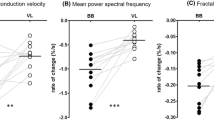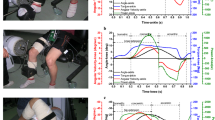Summary
The present study was designed to investigate the relationship between muscle performance and electromyogram (EMG) parameters of the trunk extensor muscles in the development of fatigue. Nine subjects performed continuous isometric trunk extensions at 25% and 40% maximal voluntary contraction. The EMG signals of the longissimus thoracis, iliocostalis lumborum, multifidus and latissimus dorsi muscles were recorded. The EMG amplitude (RA-EMG) appeared to increase consistently during the contractions in all muscles, whereas the mean power frequency (MPF) showed a fairly consistent decrease during the contractions. The time constants of the exponential change of the RA-EMG and of the MPF were related to the endurance time. The prediction of endurance based on both EMG parameters appeared to yield better results than the prediction based on the relative force. In particular the time constants of the MPF changes of the multifidus and longissimus muscles appeared to be good predictors of endurance time. The consistency of the spectrum shift of EMG appeared to coincide with a reduced variability of the activation of the muscle involved.
Similar content being viewed by others
References
Biering-Sörensen F (1984) Physical measurements as risk indicators for low back trouble over a one-year period. Spine 9:106–119
Bigland-Ritchie B, Furbush F, Woods JJ (1986) Fatigue of intermittent submaximal voluntary contractions. Central and peripheral factors. J Appl Physiol 61:421–429
Blinowska A, Verroust J (1987) Low frequency power spectrum of the EMG signal. Electromyogr Clin Neurophysiol 27:349–353
Burdorf A, Riel M van, Snijders C (1992) Trunk muscle strength measurements and prediction of low-back pain among workers. Clin Biomech 7:55–58
Caldwell LS, Chaffin DB, Dukes-Dobos FN, Kroemer KHE, Laubach LL, Snook SH, Wasserman DE (1974) A proposed standard procedure for static muscle strength testing. Am Ind Hyg Assoc J 35:201–206
De Foa JL, Forrest WJ, Biedermann HJ (1989) Muscle fiber direction of longissimus, iliocostalis, and multifidus: landmarks derived from reference lines. J Anat 163:243–247
De Luca CJ (1984) Myoelectric manifestations of localized fatigue in humans. CRC Crit Rev Bioeng 11:251–279
De Vries HA (1968) EMG fatigue curves in postural muscles. A possible etiology for low back pain. Am J Phys Med 47:175–181
Dieën JH van, Oude Vrielink HHE (1993) The use of the relation between relative force and endurance time. Ergonomics (in press)
Dieën JH van, Toussaint HM, Thissen CEAM, Ven AJGM van de (1993) Spectral analysis of erector spinae EMG during intermittent isometric fatiguing contractions. Ergonomics (in press)
Dieën JH van, Oude Vrielink HHE, Toussaint HM (1993) An investigation into the relevance of the pattern of temporal activation with respect to erector spinae muscle endurance. Eur J Appl Physiol 66:70–75
Duchêne J, Goubel F (1990) EMG spectral shift as an indicator of fatiguability in a heterogeneous muscle group. Eur J Appl Physiol 61:81–87
Dul J (1988) A biomechanical model to quantify shoulder load at the workplace. Clin Biomech 3:124–128
Dul J, Johnson GE, Shiavi R, Townsend MA (1984) Muscular synergism II. A minimum fatigue criterion for load sharing between synergistic muscles. J Biomech 17:675–684
Farrell M, Richards JG (1986) Analysis of the reliability and validity of the kinetic communicator exercise device. Med Sci Sports Exerc 18:44–49
Hagberg M (1981) Muscular endurance and surface electromyogram in isometric and dynamic exercise. J Appl Physiol Respir Environ Exerc Physiol 51:1–7
Huijgens JJM (1981) A model for quantifying static load, incorporating muscle fatigue. In: Buskirk WC (ed) Biomechanics symposium, Boulder, Colo., USA, June 22–24, 1981. American Society of Mechanical Engineers, New York, pp 97–99
Jayasinghe WJ, Harding RH, Anderson JAD, Sweetman BJ (1978) An electromyographic investigation of postural fatigue in low back pain: a preliminary study. Electromyogr Clin Neurophysiol 18:191–198
Jørgensen K, Nicolaisen T (1987) Trunk extensor endurance: determination and relation to low-back trouble. Ergonomics 30:259–267
Jørgensen K, Nicolaisen T (1991) Isometric trunk extensor endurance in young females. In: Marshall RN, Wood GA, Elliot BC, Ackland TR, McNair PJ (eds) XIIIth International Congress on Biomechanics. Book of abstracts. University of Western Australia, Perth, pp 16–17
Jørgensen K, Fallentin N, Krogh-Lund C, Jensen B (1988) Electromyography and fatigue during prolonged, low-level static contractions. Eur J Appl Physiol 57:316–321
Juel C (1988) Muscle action potential propagation velocity changes during activity. Muscle Nerve 11:714–719
Karvonen MJ, Viitasalo JT, Komi PV, Nummi J, Jarvinen T (1980) Back and leg complaints in relation to muscle strength in young men. Scand J Rehabil Med 12:53–59
Komi PV, Tesch P (1979) EMG frequency spectrum, muscle structure, and fatigue during dynamic contractions in man. Eur J Appl Physiol 42:41–50
Kranz H, Williams AM, Cassel J, Caddy DJ, Silberstein RB (1983) Factors determining the frequency content of the electromyogram. J Appl Physiol Respir Environ Exerc Physiol 55:392–399
Kranz H, Cassel JF, Inbar GF (1985) Relation between electromyogram and force in fatigue. J Appl Physiol 59:821–825
Lindström L, Magnusson R, Petersen I (1974) Muscle load influence on myo-electric signal characteristics. Scand J Rehabil Med [Suppl] 3:127–148
Lindström L, Kadefors R, Petersen I (1977) An electromyographic index for localized muscle fatigue. J Appl Physiol 43:750–754
Linssen WHJP, Stegeman DF, Joosten EMG, Binkhorst RA, Merks MJH, Laak HJ ter, Notermans SLH (1991) Fatigue in type I fiber predominance: a muscle force and surface EMG study on the relative role of type I and type II muscle fibers. Muscle Nerve 14:829–837
Looze MP de, Kingma I, Bussmann JBJ, Toussaint HM (1992) Validation of a dynamic linked segment model to calculate joint moments in lifting. Clin Biomech 7:161–169
Mathijsse PC, Hendrich KMM, Rijnsburger WH, Woittiez RD, Huijing PA (1987) Ankle angle effects on endurance time, median frequency and mean power of gastrocnemius EMG power spectrum: a comparison between individual and group analysis. Ergonomics 30:1149–1159
McKenna MJ (1992) The role of ionic processes in muscular fatigue during intense exercise. Med Sci Sports Exerc 13:134–145
McNeill T, Warwick D, Andersson GBJ, Schultz A (1980) Trunk strengths in attempted flexion, extension and lateral bending in healthy subjects and patients with low back disorders. Spine 5:529–538
Merletti R, Knaflitz M, De Luca CJ (1990) Myoelectric manifestations of fatigue in voluntary and electrically elicited contractions. J Appl Physiol 69:1810–1820
Merletti R, Lo Conte LR, Orizio C (1991) Indices of muscle fatigue. J Electromyogr Kinesiol 1:20–33
Monod H, Scherrer J (1965) The work capacity of a synergic muscle group. Ergonomics 8:329–338
Moritani T, Muro M, Nagata A (1986) Intramuscular and surface electromyogram changes during muscle fatigue. J Appl Physiol 60:1179–1185
Nicolaisen T, Jørgensen K (1985) Trunk strength, back muscle endurance and low-back trouble. Scand J Rehabil Med 17:121–127
Nicolaisen T, Jørgensen K (1990) Muscle fibre distribution and capillarization in lumbar paravertebral muscles of young males. In: Anderson P, Hobart D, Danoff J (eds) International Society of Electrophysiological Kinesiology, 8th International Congress. Program and abstract book. ISEK, Baltimore
Rohmert W (1959) Statische Belastung bei gewerblicher Arbeit. Forschungsberichte des Landes Nordrhein-Westfalen no. 793. Westdeutscher Verlag, Cologne
Rohmert W (1960) Ermittlung von Erholungspausen für statische Arbeit des Menschen. Int Z angew Physiol einschl Arbeitsphysiol 18:123–164
Roy SH, De Luca CJ, Casavant DA (1989) Lumbar muscle fatigue and chronic lower back pain. Spine 14:992–1001
Roy SH, De Luca CJ, Snyder-Mackler L, Emley MS, Crenshaw RL, Lyons JP (1990) Fatigue, recovery, and low back pain in varsity rowers. Med Sci Sports Exerc 22:463–469
Sahlin K, Ren JM (1989) Relationship of contraction capacity to metabolic changes during recovery from a fatiguing contraction. J Appl Physiol 67:648–654
Seidel H, Beyer H, Brauer D (1987) Electromyographic evaluation of back muscle fatigue with repeated sustained contractions of different strengths. Eur J Appl Physiol 56:592–602
Sjøgaard G (1991) Role of exercise induced potassium fluxes underlying muscle fatigue: a brief review. Can J Physiol Pharmacol 69:238–245
Smidt G, Herring T, Amundsen L, Rogers M, Russell A, Lehman T (1983) Assessment of abdominal and back extensor function. A quantitative approach and results for chronic low back pain patients. Spine 8:211–219
Thorstensson A, Carlson H (1987) Fibre types in human lumbar back muscles. Acta Physiol Scand 131:195–202
Troup JDG, Chapman AE (1972) Changes in the waveform of the electromyogram during fatiguing activity in the muscles of the spine and hips: the analysis of postural stress. Electromyography 12:347–365
Vink P, Daanen HAM, Verbout AJ (1989) Specificity of surface-EMG on the intrinsic lumbar back muscles. Hum Mov Sci 8:67–78
Vollestad NK, Sejerstedt OM, Bahr R, Woods JJ, Bigland-Ritchie B (1988) Motor drive and metabolic responses during repeated submaximal contractions in humans. J Appl Physiol 64:1421–1427
Author information
Authors and Affiliations
Rights and permissions
About this article
Cite this article
van Dieën, J.H., Vrielink, H.H.E.O., Housheer, A.F. et al. Trunk extensor endurance and its relationship to electromyogram parameters. Europ. J. Appl. Physiol. 66, 388–396 (1993). https://doi.org/10.1007/BF00599610
Accepted:
Issue Date:
DOI: https://doi.org/10.1007/BF00599610




